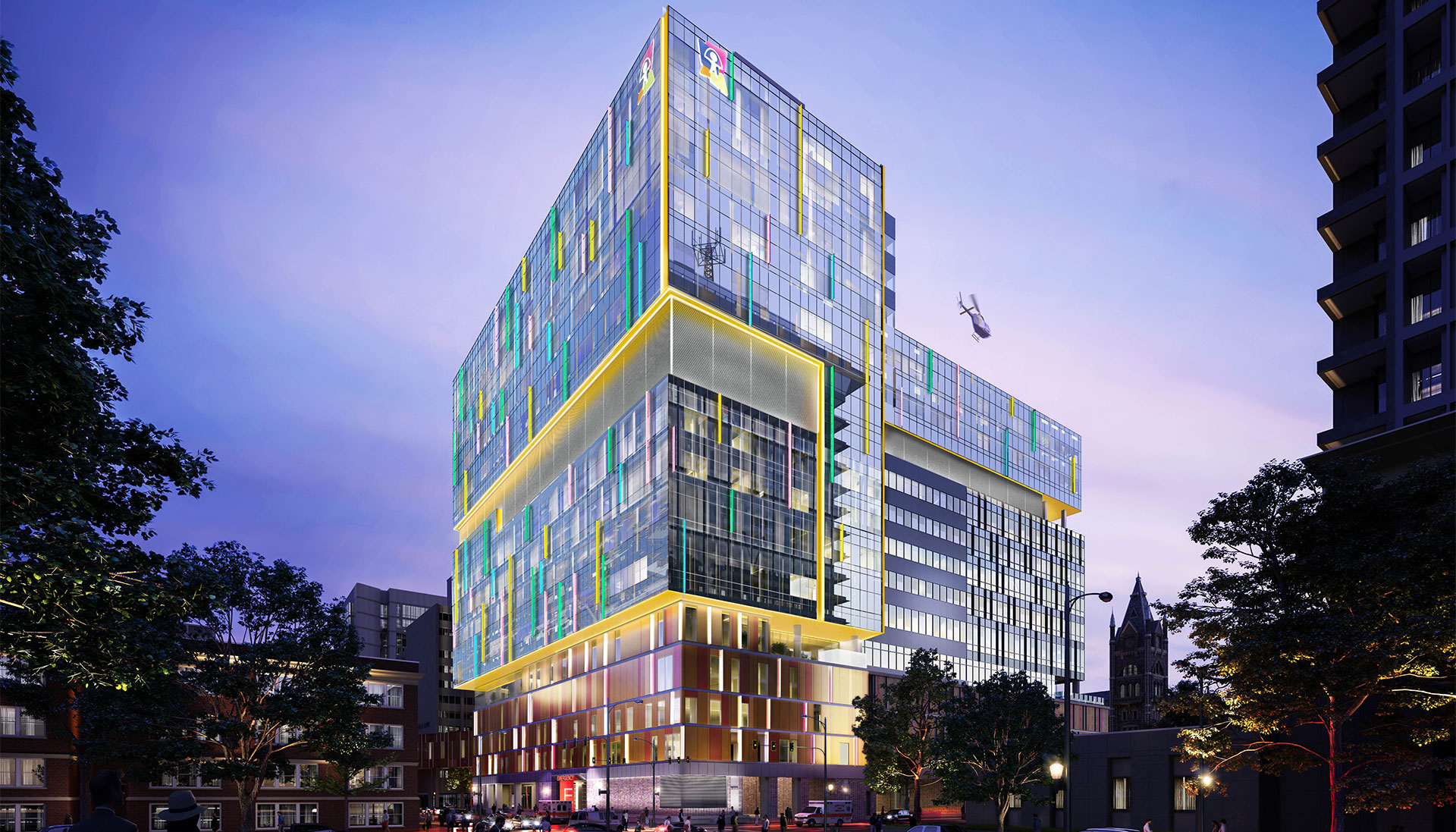A six-story, 180,000-sf patient tower addition to BayCare St. Joseph’s Hospital in Tampa, Fla., was well under way when, in the summer of 2020, the healthcare system wanted to open three patient floors earlier than scheduled to accommodate the COVID-19 pandemic’s anticipated surge.
The project’s construction manager, Robins & Morton, brought in additional supervisory staff to coordinate this compressed schedule with other building team members, which included AE firm HOK and structural engineer Carastro Engineering. As a result of this collaboration, the tower opened two months early, in July 2020, says Robins & Morton’s President and COO Robin Savage.
This has been a common tale during the pandemic, told by AEC firms whose healthcare clients want their projects up and running quicker, a task made more complicated by the shortage of skilled labor in many markets.
“A major challenge has included changes made during design and construction while maintaining the budget,” states Matthew Holmes, Global Solutions Director of Health Infrastructure for the construction management firm Jacobs, 70 percent of whose healthcare-related work last year involved in-patient design. To mitigate this issue, Jacobs continuously forecasts estimates during a project to leverage proper budgeting. “Taking the time to accurately scope the project in the budgeting process is essential,” Holmes says.
“The healthcare core market continues to operate on razor-thin margins,” observes Hamilton Espinosa, DPR Construction’s Healthcare Core Market Leader. “The need to project value and efficiency is at the forefront of key decision-making.”
A geotechnical report conducted during preconstruction of a 32,000-sf Veterans Affairs outpatient clinic in Johnson County, Kan., uncovered an unexpected need for rock excavation totaling $150,000. McCownGordon Construction, the project’s CM, reduced that allowance to $100,000 by rerouting the water, fire, and storm utilities, recalls Daniel Lacy, the firm’s Vice President−Healthcare and Life Sciences.
Many of Jacobs’ healthcare projects entail what Holmes calls “progressive design-build,” where the designer and builder work together “from day one with an established budget and program description.” Early project team engagement, asserts Pepper Construction’s Project Director Brian Mullen, CHC, LEED AP, is critical because “it leads to more informed design.” And by remaining flexible to accommodate future improvements in interior remodeling, Pepper “can help ensure that clients are prepared to incorporate the latest technology.”
By aligning a project manager with key designer, trade partner, and healthcare system personnel, McCarthy Building Companies is able to “triage” questions and ask only what’s needed to move the project forward. Then, it can provide options for consideration, says Patrick Peterson, McCarthy’s Executive Vice President of Healthcare for the Southern California region.
AEC firms have had to be creative to find skilled labor to complete healthcare projects within time and budget parameters. To connect with smaller and more diverse subcontractors, Skanska breaks up its bid packages “to widen the labor pool,” says Chris Hopper, its Vice President and General Manager. Skanska also conducts its Construction Management Building Blocks Training Program in its offices across the country to engage smaller subs through partnership and business development.
HEALTHCARE PROJECTS BACK ON TRACK
AEC Giants contacted for this report say they’ve been working on a wide range of healthcare projects. But the agenda for some clients shifted between 2020 and 2021.
Most of Henderson Engineers’ healthcare projects over the past year were for “temporary measures” that included infrastructure to support care for COVID-19 patients, says Mark Chrisman, Healthcare Practice Director for Henderson Engineers and Henderson Building Solutions. But since early 2021, “demand for construction and renovation projects of all sizes has reverted close to pre-pandemic levels.”

During the pandemic, DPR Construction pivoted to respond to help with clients’ immediate needs. But much of its work continued to be for new hospitals and patient tower expansions. There’s strong demand for outpatient care, too, although health systems are re-evaluating program sizes to factor the impact of virtual healthcare and remote patient monitoring for lower-acuity chronic case management, say Sean Ashcroft and Deb Sheehan, DPR’s Healthcare Core Market Leader and Healthcare Strategy Lead, respectively.
While new construction that included the nine-story Children’s Mercy Research Institute in Kansas City, Mo., accounted for McCownGordon’s largest recent healthcare projects, the majority, in terms of volume, have been adaptive reuse, says Lacy. McCarthy’s Peterson points out that healthcare clients are exploring strategies for maintaining aging buildings and repurposing existing spaces for “a changing service model.”
AEC firms are engaging more renovations and expansions, too. McCarthy recently worked on the Loma Linda University Medical Center’s Campus Transformation Project to bring it up to California’s seismic compliance requirements.
Brian Forsythe, LEED AP, CHC, Pepper’s Vice President and Project Director, predicts that clients who have delayed master-planning projects will need to move forward to remain competitive. And he cites a trend toward public-private partnerships to fund healthcare projects, such as the University of Illinois Health’s 205,000-sf Outpatient Surgery Center and Specialty Clinics in Chicago, for which Provident Resources Group, a 501(c)(3) corporation, is financing three-quarters of the building’s $194 million total cost through tax-exempt bonds, and will lease the building to UI Health during the 30-year term of the bonds. This project should be completed next year.
UNIVERSAL PATIENT ROOMS ARE IN VOGUE
Alternative project delivery is among the design and construction trends that have emerged in the healthcare sector. The University of Illinois project, designed by Shive Hattery, deployed modular construction to stay within budget. One of Robins & Morton’s priorities is to determine how to leverage prefabrication and modularization, says Savage. And during the pandemic, the controlled environment and potentially higher production rates that prefab offers “took on a renewed sense of urgency” for McCarthy. Peterson says prefab systems his firm now focuses on include exterior envelopes, framing and wall panels, MEP, medical and interiors, bathrooms, and vertical transportation.
Skanska is among the AEC firms that have been getting more requests for larger private and “universal” rooms. For its University of Virginia Health System hospital expansion in Charlottesville, Skanska built a patient tower with fully ICU-compliant universal patient beds. Chrisman of Henderson Engineers says that healthcare providers are showing a “strong desire” to establish permanent isolation rooms to manage patients during infectious disease outbreaks.
Other trends in healthcare projects that Jacobs’ Holmes is seeing include high-end technology for patient and procedural spaces, combined heat and power turbines for steam and electricity, combined pre- and post-recovery bays, more space allotted for telehealth and behavioral health, and growth in emergency departments.
The Phoenix-based architectural planning and interior design firm Orcutt | Winslow has experimented lately with alternate structural solutions to steel framing and joists, such wide-flange structural frames and steel-masonry hybrids. The firm is also increasingly using Lean approaches, such as pull planning, to improve a project’s speed to market, says Chuck Hill, its Healthcare Studio Leader.
Matthew Kennedy, Orcutt | Winslow’s Senior Healthcare Planner, adds that his firm has tried out several digital media platforms—such as Miro and Microsoft Teams—for communications and file sharing. It’s not alone, as virtual interaction has become the norm in a socially distanced world.
When the pandemic hit, Skanska saw an opportunity to use StructionSite, a project site photo documentation software, to conduct virtual job walks abetted by advanced imagery and video. Pepper leverages web-based platforms “to bring everyone to the jobsite virtually,” says Forsythe. During the pandemic, Pepper also launched Virtual Reality Training modules, and expanded its use of TouchPlan with the Last Planner System for digital pull planning. Robins & Morton’s application of technology for healthcare projects includes entirely virtual mockups, 3D printing, augmented reality, and testing robots to photograph and laser-scan jobsites.
SUSTAINABLE AND RESILIENT HEALTHCARE BUILDINGS
Healthcare systems are trying to change their reputation for being profligate users of energy and water by seeking project solutions for efficiency, carbon neutrality, sustainability, and resilience.
Savage of Robins & Morton points out that healthcare clients are interested in stemming carbon emissions that are mostly released from the material supply chain before a new or renovated facility even opens. Skanska’s Hopper cites a 2020 Health Affairs study, which estimated that the healthcare industry accounted for more than 8 percent of CO2 emissions in the U.S. “Healthcare systems have made carbon reduction a part of their collective mission and values,” says Hopper.
Concerns about embodied carbon can be tied to a larger effort among healthcare systems and their AEC partners in favor of environmental sustainability and resilience. One of Robins & Morton’s projects—the recently completed Fisherman’s Community Hospital in Marathon, Fla.—sits on higher elevation to combat storm surges, has a tilt-up concrete core, and includes impact-resistant exterior and removable flood barriers.
Chrisman expects larger healthcare systems with financial means to be the main drivers of sustainability and resilience over the next decade. Client demand was one of the reasons why Henderson last April hired its first director of sustainability, Brian Alessi, AIA, LEED AP BD+C, who has worked on more than 400 LEED-certified, net-zero, and passive house projects.
By August 29, Louisiana had evacuated 22 nursing homes and 18 assisted living facilities as Category 4 Hurricane Ida was pounding that state’s coast. However, 2,400 COVID-19 patients still in Louisiana hospitals hadn’t been moved, partly because there was no other place to put them, but also because modern hospitals are better prepared to stay open during natural disasters.
“COVID-19 has made clear there is a need to increase and maintain resilient healthcare systems through a holistic approach to how, when, and where we access care,” says Jacobs’ Holmes. “Sustainability is a required item and, at Jacobs, that means ensuring long-term business resilience.”
McCarthy’s Peterson says that resilience “is built into every healthcare design we see.” And Hill of Orcutt | Winslow is confident that once this sector is less distracted by its immediate supply-chain issues, “resilience will emerge as a driver” for healthcare projects.
Related Stories
| Aug 11, 2010
HDR, Perkins+Will top BD+C's ranking of the nation's 100 largest healthcare design firms
A ranking of the Top 100 Healthcare Design Firms based on Building Design+Construction's 2009 Giants 300 survey. For more Giants 300 rankings, visit http://www.BDCnetwork.com/Giants
| Aug 11, 2010
Diffenbaugh completes construction of Loma Linda University Highland Springs Medical Plaza
J.D. Diffenbaugh, Inc. has completed construction of the new Highland Springs Medical Center for California's Loma Linda University Medical Center that will significantly enhance the access to medical services for families in the Inland Empire. The project was developed by Lillibridge Healthcare Services, Inc., one of the nation’s largest private healthcare real estate firms.
| Aug 11, 2010
Arup, SOM top BD+C's ranking of the country's largest mixed-use design firms
A ranking of the Top 75 Mixed-Use Design Firms based on Building Design+Construction's 2009 Giants 300 survey. For more Giants 300 rankings, visit http://www.BDCnetwork.com/Giants
| Aug 11, 2010
Structure Tone, Turner among the nation's busiest reconstruction contractors, according to BD+C's Giants 300 report
A ranking of the Top 75 Reconstruction Contractors based on Building Design+Construction's 2009 Giants 300 survey. For more Giants 300 rankings, visit http://www.BDCnetwork.com/Giants
| Aug 11, 2010
Best AEC Firms of 2011/12
Later this year, we will launch Best AEC Firms 2012. We’re looking for firms that create truly positive workplaces for their AEC professionals and support staff. Keep an eye on this page for entry information. +
| Aug 11, 2010
Call for entries: Building enclosure design awards
The Boston Society of Architects and the Boston chapter of the Building Enclosure Council (BEC-Boston) have announced a High Performance Building award that will assess building enclosure innovation through the demonstrated design, construction, and operation of the building enclosure.







